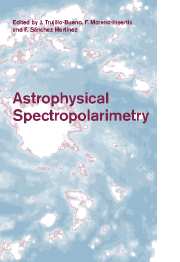Book contents
- Frontmatter
- Contents
- Participants
- Group Photograph
- Preface
- Foreword
- Acknowledgements
- The Physics of Polarization
- Polarized Radiation Diagnostics of Solar Magnetic Fields
- Polarized Radiation Diagnostics of Stellar Magnetic Fields
- Polarization Insights for Active Galactic Nuclei
- Compact Objects and Accretion Disks
- Astronomical Masers and their Polarization
- Interstellar magnetic fields and infrared-submillimeter spectropolarimetry
- Instrumentation for Astrophysical Spectropolarimetry
The Physics of Polarization
Published online by Cambridge University Press: 21 May 2010
- Frontmatter
- Contents
- Participants
- Group Photograph
- Preface
- Foreword
- Acknowledgements
- The Physics of Polarization
- Polarized Radiation Diagnostics of Solar Magnetic Fields
- Polarized Radiation Diagnostics of Stellar Magnetic Fields
- Polarization Insights for Active Galactic Nuclei
- Compact Objects and Accretion Disks
- Astronomical Masers and their Polarization
- Interstellar magnetic fields and infrared-submillimeter spectropolarimetry
- Instrumentation for Astrophysical Spectropolarimetry
Summary
This course is intended to give a description of the basic physical concepts which underlie the study and the interpretation of polarization phenomena. Apart from a brief historical introduction (Sect. 1), the course is organized in three parts. A first part (Sects. 2-6) covers the most relevant facts about the polarization phenomena that are typically encountered in laboratory applications and in everyday life. In Sect. 2, the modern description of polarization in terms of the Stokes parameters is recalled, whereas Sect. 3 is devoted to introduce the basic tools of laboratory polarimetry, such as the Jones calculus and the Mueller matrices. The polarization phenomena which are met in the reflection and refraction of a beam of radiation at the separation surface between two dielectrics, or between a dielectric and a metal, are recalled in Sect. 4. Finally, Sect. 5 gives an introduction to the phenomena of dichroism and of anomalous dispersion and Sect. 6 summarizes the polarization phenomena that are commonly encountered in everyday life. The second part of this course (Sects. 7-14) deals with the description, within the formalism of classical physics, of the spectro-polarimetric properties of the radiation emitted by accelerated charges. Such properties are derived by taking as starting point the Liénard and Wiechert equations that are recalled and discussed in Sect. 7 both in the general case and in the non-relativistic approximation. The results are developed to find the percentage polarization, the radiation diagram, the cross-section and the spectral characteristics of the radiation emitted in different phenomena particularly relevant from the astrophysical point of view.
- Type
- Chapter
- Information
- Astrophysical Spectropolarimetry , pp. 1 - 54Publisher: Cambridge University PressPrint publication year: 2001
- 1
- Cited by

